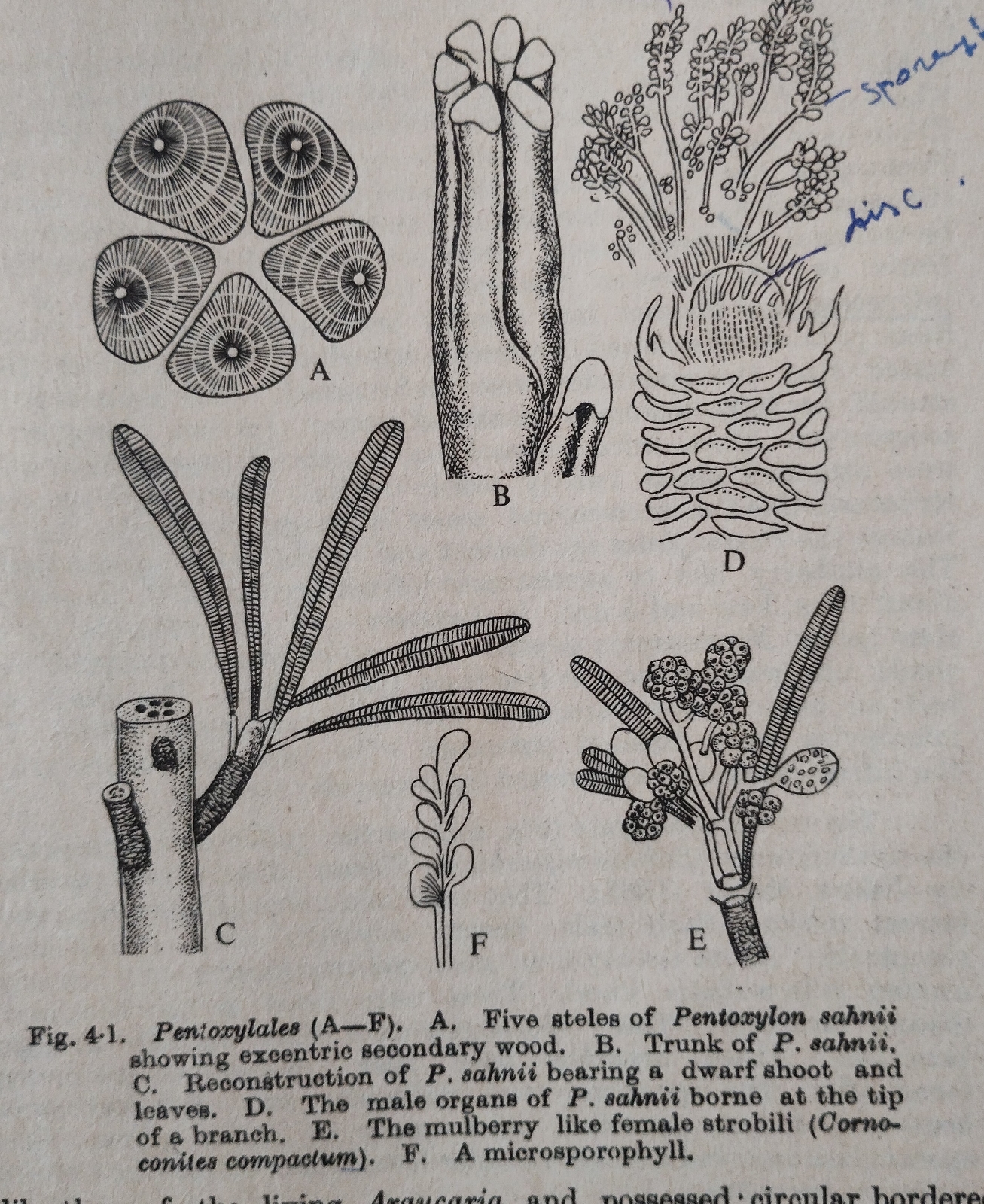CORDAITES
Cordaites is a reconstructed fossil plant/extinct plant (upto 30 mt high ) and it was originated during Upper Devonian , climaxed at Upper Carboniferous and declined at the beginning of Triassic period (about 225 million years ago ) .
Systematic position:
Division. ........Gymnosperms
Class .........Coniferopsida
Order............Cordaitales
Family........Cordaitaceae
Genus......Cordaites
This group of coniferous gymnosperms were named after Corda . Order Cordaitales comprises of a single family Cordaitaceae . A total of 4 genera and 26 species were discovered from Indian Gondwana Flora which are represented in the form of impression and compression of leaves ,seeds and permineralised woods. A large number of different form-genera of Cordaitales have been reported by different palaeobotanists from China ,Siberia ,North America,Europe ,and Australia also.Different form-genera of Cordaitales are as follows :
Plant parts. Form genera
Root. Amyelon
Stem. Mesoxylon, Dodoxylon
Leaf. Cordaites
Fructification. Cardaianthus
Seed Cardiocarpus
Pollengrain Florinites
Genus No of specis
Cordaicarpus 4
Dodoxylon 14
Noeggerathiopsis 3
Samaropsis 5
Different members of Indian representative are in the above table .
Description of root form genera.
Stele : Central part is occupied by metaxylem and this triarch is surrounded by protoxylem.Hence,the xylem is mesarch and the slele is protostelic and the type is actinostelic.
The primary xylem core is surrounded by a wide ring of secondary xylem.
Around the solid xylem core few layered phloem ring is present.
Cortex : Stele is surrounded by cortex which is divided into inner and outer .
Inner cortex : It is made up of 4 to 6 layered dark coloured parenchymatous tissue and interupted by michorhizal hyphae.
Cambium ring : A distinct cambium ring is present in between the inner and outer cortex.
Outer Cortex :Multilayered uneven outer cortex have been considered as the periderm which has many dotted lenticels.
Stem anatomy
There are many stem form-genera of Cordaitales such as Mesoxylon ,Dodoxylon ,Pennsylvanioxylon, Metacordaites,Artisia,etc. Arnold in 1967 proposed the name Cordaioxylon.
Pith : Presence of large parenchymatous discoid pith shows that stem is Siphonostelic. The pith has large air chambers seperated by diaphragms in Artisia and Sternbergia.
Xylem :
The pith is surrounded by primary xylem ring.In case of Pennsylvanioxylon the primary xylem is endarch but mesarch in Mesoxylon.The protoxylem have spiral thickenings but reticulate and scalariform in metaxylem.
The tracheids of secondary xylem have hexagonal bordered pits. The pycnoxylic wood/secondary xylem is interupted by uniseriate rays.
Phloem :
Traces of preserved secondary phloem present in between wood and cortex consist of radially arranged sieve tubes, parenchyma . Presence of fibres is doubtful.
The vascular bundles were open.
Leaf traces :
A good number of leaf traces are found in cortex with centripetal primary xylem in Pennsylvanioxylon but both of centripetal and centrifugal in Mesoxylon.
Cortex : In younger stage peripheral wide parenchymatous cortex contain sectetory sacs and at older stage cortex is replaced by periderm due to secondary growth.
Leaf structure : Cordaites is the leaf form-genus.
Morphology : Leaves are simple, sessile, 1mt long, linear,lanceolate;venation parallel and spirally arranged.
The genus Cordaites has been divided into three Sub-genus.
Sub-genus 1 :Eu-Cordaites : Leaves spathulate ,leaf apex obtuse,1mt long,15cm wide.
Sub-genus 2 : Dory-Cordaites : Leaf apex pointed and shape lanceolate.
Sub-Genus 3 :Poa-Cordaites : Leaves grass like ,50 cm long,1 cm wide.
Leaf anatomy :
Epidermis : Upper and lower epidermal cells are thick walled and heavily cutinised. Lower epidermis has haplochellic stomata which has six subsidiary cells out of which two are polar.
Hypodermis : Sclerenchymatous hypodermis of both sides are connected by bundle sheath .
Pallisade and spongy parenchyma : The differen
ciation of pallisade layer and spongy layer is poor with a large numbers of lacunae in between the veins.
Xylem :In the vascular bundles masarch xylem is located at the upper side.
Phloem :Below the xylem there is phloem patches.
Bundle sheth is two layered and Sclerenchymatous.
Structure of male and female fructification :
Form-genus Cordaianthus is the both types of the fructification which occur among the leaves in loose inflorescence or compact cone.
Male cone:
The male cone is a secondary dwarf shoot in the
axil of a bract. The cone is 6mm long with a central axis bearing 25--40 spirally arranged scales among them 5--10 distal scales fertile , whereas remaining proximal are sterile.
There are 4 microsporangia at the tip of the fertile scale in C. saportanus and 6 in case of C.penjoni and C.concinnus .The microsporangia fused at the base.
The primary axis is flat with bilateral symmetry.
Each microsporangia is fingure-like in shape and
Jacket is single layered a large number of pollens
Florinites is the best studied form genus pollen
Each one ranges 65-- 150 micro mt having an air cavity enclosed by exine.
Female cone:
It is also a secondary shoot at the axil of the bract of the main axis.
In C.pseudofluitans there are 16-20 spirally arranged scales out of which distal 4--6 are fertile . At the apex of the fertile scale there is a single reflexed ovule.
Structure of the ovule/ seed:
Each seed is cordate, flat with bilateral symmetry .
Integument has three layers :
(I) outer fleshy Sarcotesta,
(II) middle stony Sclerotesta and
(III) inner narrow Endotesta.
The parenchymatous nucellus is inner to the integument and having a gap between them. The distal part of the nucellus forms the beak containing the micropyle and the pollen chamber.
There is a distinct vascular strand at the base of the chalaza.In many cases a tent pole and two archegonia are well presserved at the micropylar end.








Comments
Post a Comment